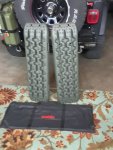I guess I'm raining on this parade by saying you don't need MaxTraxs. Anytime you need to build a ramp of any kind indicates a lack of pressure regulation of the tires; a lack of floatation, unless it's bottomless mud or sky high rocks. In that case you need to reevaluate the need to enter anyway. Hard core jeepers have known this for decades. We've adjusted the tire pressure to fit many situations and vehicles. My old CJ-8 with 37x13.50R16 tires were dropped to 10 pounds as soon as we got on dirt. If encountering bottomless sand and dunes, more air was let out down to a minimum of 3 pounds. Never lost a bead due to low pressure. I'm even more fickle when it comes to my 10K pound truck camper. More to loose i guess. Who's going to get you out? 65 to 80 pounds street pressure (depending) drops to 30-32 pounds as soon as we hit long stretches of dirt.

We read the road surface, sometimes dropping down to an absolute minimum of 20 pounds for blow sand, dune running and sandy washes. After I learned to regulate the pressure to fit the surface, getting stuck was a thing of the past. Here's a link to a recent run up the "Diablo Drop Off" in Anza Borrego. It's about a 300 foot climb up blowsand with deep moguls near the top. My bro tried first in his Ford F-250 diesel 6 speed @ 30 pounds pressure and in 3rd gear low range. He got about 1/2 way up the hill and slowly sank to the frame. Pressure too high. Wrong gear. He reported this to me on the Motorola and bade me lower to 20 pounds and try 4th gear low range, downshifting to 2nd for the moguls, as he slowly backed down making sure he was strait arrow. We both have 6-speeds. The result:
https://www.dropbox.com/s/bfj5y93wsd7vfkw/jefe does sand hill at dry wash of the devil Anza.m4v?dl=0
One caveat is that I am running 35 inch AT-3's, (315x75R16) which are not grave diggers and on super single rims on the rear which allows the low pressure footprint to spread out to about a 14 inch by 15 inch patch, much of it on the sidewalls.

When going uphill much of the weight (about 6K pounds) of the TC transfers to the rear axle where the super single wheels reside. The ace in the hole is lowering the pressure quickly and just a quickly airing back up when out of the dune or soup. We use an ARB tire pressure gauge with screw out core feature. It's fast. For years we used a 30 pound CO2 tank with the correct cold temp hardware to air endless tires back up at the end of the day all week at Moab. Now, with just the truck and camper I have a Viair 440, which will pump those meats up to 65 or 80 with a pretty good duty cycle without dissolving into a smoldering, one-piece, no moving parts mess, unlike the cheap compressors from China Freight.
About those who have gotten stuck and had nothing to winch to. No trees; no rocks; no other vehicles. If you have a winch; all is not lost. Depending on the surface, and especially if it's sandy, you can use the 'Dead Man' technique. A bit arduous, but none the less do able. In decades past, I had the pleasure to treat three Japanese businessmen to a day in the desert in my FJ-55/Chevy/Warn winch about 1974. As you will see, the only English they spoke that day was, "DEADMAN!" We shot the dunes and ran up and down arroyos and finally tried to cross the WhiteWater River; a 50 foot across, sandy bottom, fast running snowmelt stream. I started across and we were soon up to the winch but still moving. I had a stack and the Chevy V-8 engine was pretty high up in the engine compartment so it was still running, but I couldn't see the 32 inch tires anymore and water was coming across the gunnels when we finally stopped forward motion. Wading out past the wide-eyes Japanese businessmen peering out the window, I opened the back and plucked out my spare tire, which thankfully was on the cargo floor and not underneath. I oinked the tire to shore and rolled it another 30 feet past shore. I then waded back to get my shovel and pick up the winch hook; winch now in neutral. The winch was the old Warn 8000, with 125 feet of 5/16 wire rope. I dug a hole about a foot wider than the size of the tire, and kept digging, occasionally looking back at the still wide eyed businessmen starring through the front window in the still idling FJ. Actually, the rig was slowly listing as the sand underneath the uphill side wheels was being eroded away. At about the 3-1/2 foot level i climbed out and hooked the winch hook through the center hole surrounding the X-tire iron and lowered the tire to the bottom. After burying the tire, only the secure wire rope was coming out of the sand and gravel. I wadded back to the winch and put it in gear, crawling back in the jeep and using the controls inside. The winch did most of the work and the tires very little in this case, but we were moving. Up and over the bank we kept on right up to the buried spare. Dig the tire back up. Replace the spare. Wind in the wire rope. All the way back to L.A. i could discern only one English word in their rapid conversation in Japanese: an occasional exclaimation, "DEAD MAN!" I think they got their money's worth.
jefe









